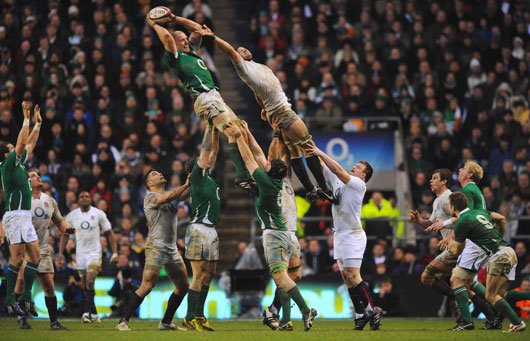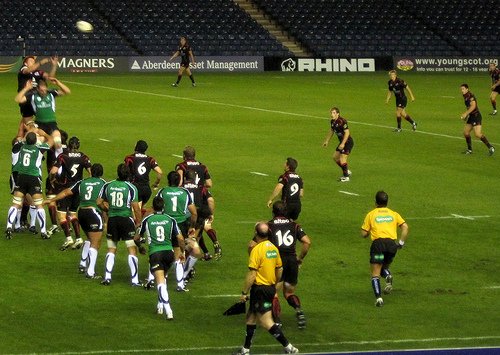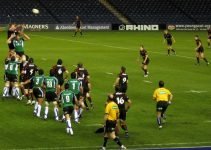THE LINEOUT IN RUGBY UNION
To a first time viewer the rugby lineout must look as choreographed and graceful as the rugby scrum looks brutal and explosive. In what can only be described as a weird performing arts spectacle, two lines of players yell out unintelligible coded words then run back and forth till a number of them get spontaneously lifted into the air to try and catch a ball. What we are seeing is the rugby union lineout, one of the most contested components of the game of rugby union, not to mention the most nerve-racking to viewers.

In rugby union, play stops when the ball is kicked over the sideline. The game then resumes with a rugby line out. The rugby line-out is usually formed where the ball passed over the sideline. However, if the kick goes out on the full then it is taken back to where the kick was made, although there are a couple of exceptions to this in rugby union. If the team has been awarded a penalty the ball may be kicked out on the full and still retain the lineout. The other exception is the 22 metre rule, which will be discussed later. As with most elements of rugby the line-out, is contestable.
This article about the rugby line-out is part of a series of rugby basics brought to you by RugbyFix. These Rugby 101 articles are designed to help new viewers understand more about the great game of rugby. Check out these other articles:
- What is Rugby?
- Rugby Positions
- The Scrum
HOW THE LINEOUT WORKS
When the ball goes out in rugby union, play resumes with a rugby lineout. Here each team stands in a line one metre apart and 5 metres out from the point of the sideline where the ball went out. The hooker whose team did not kick it out throws the ball down the middle of the line out and each team tries to hoist players up to catch the ball. Another advantage to the throwing team is that they decide the maximum amount of players in the lineout, with the minimum number is two from each side. The opposing team can match or have less team members contesting the lineout, but they cannot exceed the player numbers used by the throwing team.These technical aspects make rugby union lineouts highly contestable.
Furthermore, there are a variety of technical requirements that if not met will result in the opposing team being awarded possession. These include the ball not being thrown in straight or not quickly enough, players being lifted too early or closing the gap between the teams. Read on to learn more about how the lineout works, how it influences rugby tactics, the 22 metre rule, lineout calls, plays and moves.
THE 22 METRE RULE AND THE LINEOUT
To new rugby union viewers the 22 metre rule may seem a bit of a gimmick. If the ball goes out on the full then the rugby lineout takes place from where it was kicked. In other words, kicking the ball so it goes out without bouncing is usually a costly mistake. However, the exception in rugby union is if the ball is kicked out behind the kicker’s 22 metre line. Unless the ball is passed from in front of the 22 to the kicker, then play restarts from where it went out whether it bounced first or not. Up until recently the ball could also be passed back into the 22 as well, but not carried back.
The 22 metre rule is very common in rugby union because it is a good way of gaining territory and a chance to contest possession at the rugby lineout.
RUGBY LINEOUT CALLS
Ever noticed the weird randomised sequence of unintelligible words being yelled in the lineout? You could be forgiven for simply using it as another contributor to the unfair stereotype of forward rugby player intelligence. However, what you are actually seeing is a carefully crafted code known as a lineout call. A lineout call or code is used to communicate the throwing and catching strategy for that lineout. You will often see one of the more experienced players yelling the code in the direction of the hooker. This is the lineout caller, and he is either using a pre-decided call or making deciding on one on the spot that is reacting to how the opposition is set. Naturally, this provides the throwing team with a huge advantage because, providing the hooker is accurate, they know exactly where the ball is going to go and who should jump or be lifted to catch it.
The lineout call usually determines what happens immediately after the ball is caught, for example if it will be immediately passed or perhaps brought into form a maul. This will be discussed in the ‘Rugby Lineout Plays and Moves’ section.
There is a limitless number of options for lineout calls. However, hopefully they aren’t too complicated because the players may very fatigued by the time they have to recall them.
Often the call is a sequence of three words or numbers. The first word would relate to the planned catcher, the second to the planned location in the lineout, and the third for the move that is to follow.
On occasion the entire lineout sequence is a planned attacking move. A famous example of this was in the 2011 Rugby World Cup final. New Zealand had determined that France fiercely contested the opposition lineouts, usually sending up two jumpers. If France had six in the lineout, and set up two lifting pods, then there would be limited defence through the lineout. The All Blacks set a lifting pod up at the front and one at the back, which France imitated. Kaino took the ball at the back as Woodcock came back around and ran through the centre. Kaino dropped the ball down to the rampaging loosehead prop, brushed aside the tackle of tighthead prop Nicolas Mas and scored the try.
The rugby lineout move, apparently called “Teabag”, named for loosehead prop Tony Woodcock, had been used successfully against Australia a couple of years earlier, then shelved for a special occasion later. It turned out to be the only try the All Blacks scored in the final.
WATCH ONE OF THE MOST HISTORIC RUGBY LINEOUT MOVES BELOW ON THIS VIDEO:
HOW THE RUGBY LINEOUT INFLUENCES THE GAME OF RUGBY UNION
The rugby union lineout has very strategic importance in how rugby is played. Because the line-out is contestable in rugby, it makes kicking the ball out a very common and strategic option as your team has realistic chance of regaining possession in a rugby union lineout.
Also, in rugby the usual strategy is to try and ensure as much of the game is played in the opposition’s half. In fact, one of the key statistics mentioned in televised games is the amount of rugby played in each team’s half. Therefore, kicking the ball out downfield then contesting or at least disrupting the rugby lineout is a good way of keeping the play away from your tryline. Modern goal kickers can often kick penalties anywhere from the halfway line. Therefore it makes sense to try and put as much space between them and your goal posts as possible, in case your team gives away a penalty.
RUGBY LINEOUT PLAYS AND MOVES
WHAT HAPPENS AFTER THE LINEOUT?
Anything can happen during or after a lineout. Even if it is your throw in, your team may concede a penalty or a scrum to the opposing team. If the lineout is not executed properly the other team may catch the ball, or the opposing team may read your lineout and steal the ball.
However, if everything goes according to plan and the team with the throw in retains possession, then usually one of two things happen. Firstly, the player who is lifted to catch the ball holds on to it, and his team mates huddle around him and form a maul, slowly walking the ball forward. The other team is forced to combat the maul by forming a huddle of their own and pushing against the other team.
The second most common option after the rugby lineout, is that the ball is cleared as quickly as possible to the backline. For this to be as quick as possible, the lineout jumper who catches the ball throws this out to the halfback while he is still elevated in the air. The halfback will then pass this out to his backline.
Either way, the rugby lineout is now over and play resumes immediately.




